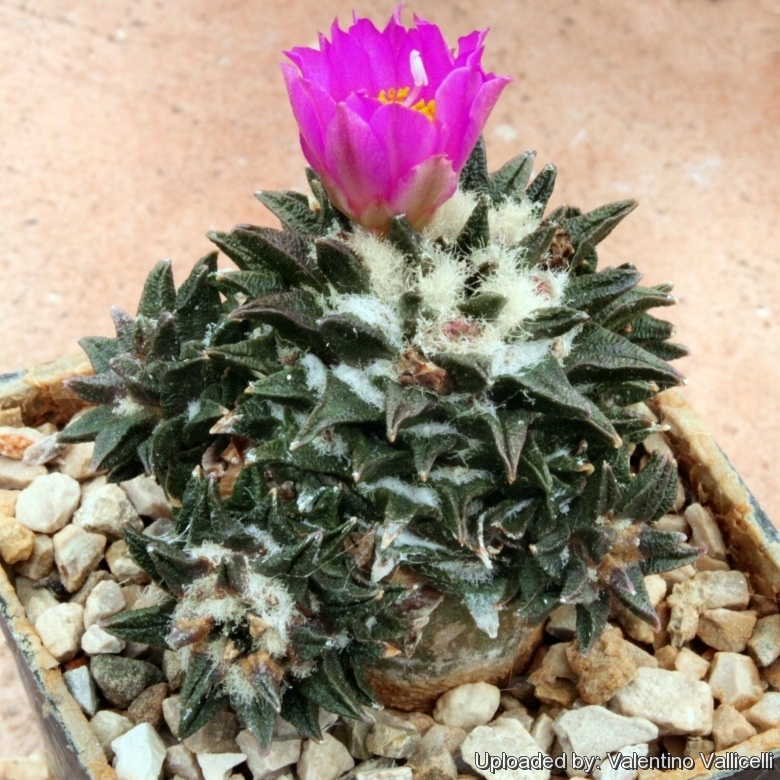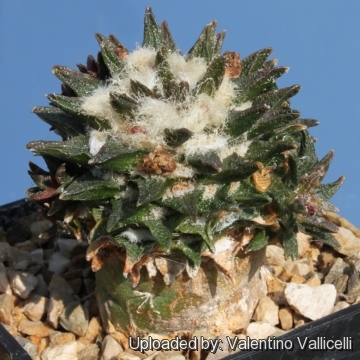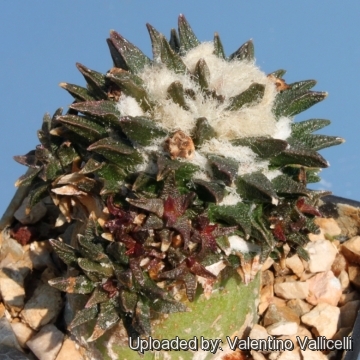Accepted Scientific Name: Ariocarpus scaphirostris
CITES Cactaceae checklist. 1992

Ariocarpus scaphirostris cv. Dwarf Form Photo by: Valentino Vallicelli
Origin and Habitat: Garden origin (Nursery produced cultivar)
Synonyms:
See all synonyms of Ariocarpus scaphirostris
back
Accepted name in llifle Database:Ariocarpus scaphirostris (Boed.) D.R.HuntCITES Cactaceae checklist. 1992Synonymy: 3
Cultivars
(1):
back
Description: Ariocarpus scaphirostris cv. Dwarf Form differs from the standard Ariocarpus scaphirostrisSN|13521]]SN|13521]] only for its reduced size and minuscule triangular tubercles, all the other characteristics clearly show that they are conspecific.
Habit: Ariocarpus scapharostris is a slow-growing grey-green, geophytic cactus rising barely above ground level.
Stem: Smaller solitary, subglobose or globose, more or less rounded on top, 3-5 cm in diameter and 2-4 cm tall.
Tubercles: Several, divergent, erect spineless, bluntly pointed at the apices, flattened and smooth adaxially, fissured, slightly incurved, 1-1,5 cm long, less than 5 mm broad, about twice as long as wide, grey wool between the tubercles.
Roots: Thick underground carrot-like root.
Flowers: Diurnal, self-fertile, bright dark purple, up to 3 cm.
Blooming season: Flowers in the Autumn, it flowers and fruits profusely.
Fruit: Greenish, 9-15 mm long 4-8 mm in diameter.
Subspecies, varieties, forms and cultivars of plants belonging to the Ariocarpus scapharostris group
Bibliography: Major references and further lectures
1) Edward Anderson “The Cactus family” Timber Press, Incorporated, 2001
2) James Cullen, Sabina G. Knees, H. Suzanne Cubey "The European Garden Flora Flowering Plants: A Manual for the Identification of Plants Cultivated in Europe, Both Out-of-Doors and Under Glass" Cambridge University Press, 11/Aug/2011
3) David R Hunt; Nigel P Taylor; Graham Charles; International Cactaceae Systematics Group. "The New Cactus Lexicon" dh books, 2006
4) Urs Eggli, Leonard E. Newton: “Etymological Dictionary of Succulent Plant Names” Springer, Berlin/Heidelberg 2010
5) N. L. Britton, J. N. Rose: “The Cactaceae. Descriptions and Illustrations of Plants of the Cactus Family.” Volume III, The Carnegie Institution of Washington, Washington 1922
6) D. Hunt. "CITES Cactaceae checklist. (CITES Cactus L)" 1992
7) E. F. Anderson and W. A. Fitz Maurice "Ariocarpus revisited." Haseltonia 5: 1-20. 1997).
8) Anderson, E. F. "Ariocarpus: Some reminiscences." Cart. Succ. J. (US) 71:180-190, 1999)
9) Stuart Max Walters “The European garden flora. 3.[Angiospermae], Dicotyledons. [Casuarinaceae to Aristolochiaceae]” Cambridge University Press, 1989
 Ariocarpus scaphirostris cv. Dwarf Form Photo by: Valentino Vallicelli
Ariocarpus scaphirostris cv. Dwarf Form Photo by: Valentino Vallicelli Ariocarpus scaphirostris cv. Dwarf Form Photo by: Valentino Vallicelli
Ariocarpus scaphirostris cv. Dwarf Form Photo by: Valentino Vallicelli Ariocarpus scaphirostris cv. Dwarf Form Photo by: Valentino Vallicelli
Ariocarpus scaphirostris cv. Dwarf Form Photo by: Valentino VallicelliSend a photo of this plant.The gallery now contains thousands of pictures, however it is possible to do even more. We are, of course, seeking photos of species not yet shown in the gallery but not only that, we are also looking for better pictures than those already present.
Read More... Cultivation and Propagation: Ariocarpus scaphirostrisSN|13521]]SN|13521]] cv. Dwarf Form is not too difficult in a greenhouse, although grows very slowly. It is often seen as a grafted plant but can grow on its own roots too.
Soil: Use mineral well permeable mineral soil with little organic matter (peat, humus).
Exposure: They need a good amount of light shade to full sun this help to keep the plants healthy, although slow growth.
Watering: Water sparingly from March till October (weekly during summertime, if the weather is sunny enough), with a little fertilizer added. Less or no water during cold winter months, or when night temperatures remain below 10° to prevent root loss. It is sensitive to overwatering (rot prone).
Fertilization: Feeding may not be necessary at all if the compost is fresh then, feed in summer only if the plant hasn't been repotted recently. Do not feed the plants from September onwards as this can cause lush growth which can be fatal during the darker cold months.
Hardiness: Keep perfectly dry in winter at temperatures from 5 to 15 degrees centigrade. (but it is relatively cold resistant and hardy to -10° C, or possibly colder for short periods) In the rest period no high atmospheric humidity!! (Temperature Zone: USDA 9-11)
Dwarfed growth: Unlike 'monstrose' varieties of plants, where the variation from normal growth is due to genetic mutation, dwarfed growth can occur on normal plants, but generally the causes are unknown. A dwarf plant looks like a normal plant, but smaller in size.
Propagation: Grafting or cuttings. Plants are usually grafted onto column-shaped cacti but proved to be able to produce their own roots if degrafted. Cuttings will take root in a minimum temperature of 20° C (but better in hot weather). Cuttings of healthy shoots can be taken in the spring and summer. Cut the stem with a sharp, sterile knife, leave the cutting in a warm, dry place for a week or weeks (depending on how thick the cutting is) until a callus forms over the wound. Once the callus forms, the cutting may be inserted in a container filled with firmed cactus potting mix topped with a surface layer of coarse grit. They should be placed in the coarse grit only; this prevents the cut end from becoming too wet and allows the roots to penetrate the rich compost underneath. The cuttings should root in 2 to 6 weeks. Large crested piece must be placed on the soil surface without burying the plant base down in the soil.














